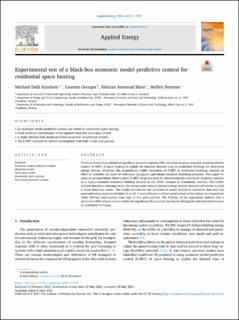| dc.contributor.author | Knudsen, Michael | |
| dc.contributor.author | Georges, Laurent | |
| dc.contributor.author | Skeie, Kristian | |
| dc.contributor.author | Petersen, Steffen | |
| dc.date.accessioned | 2022-07-07T08:02:43Z | |
| dc.date.available | 2022-07-07T08:02:43Z | |
| dc.date.created | 2021-11-24T16:16:42Z | |
| dc.date.issued | 2021 | |
| dc.identifier.citation | Applied Energy. 2021, 298 . | en_US |
| dc.identifier.issn | 0306-2619 | |
| dc.identifier.uri | https://hdl.handle.net/11250/3003382 | |
| dc.description.abstract | Previous studies have identified significant demand response (DR) potentials in using economic model predictive control (E-MPC) of space heating to exploit the inherent thermal mass in residential buildings for short-term energy storage. However, the economically viable realisation of E-MPC in residential buildings requires an effort to minimise the need for additional equipment and labour-intensive modelling processes. This paper reports on an experiment where a novel E-MPC setup was used for thermostatically control of a hydronic radiator in a highly-insulated residential building located on the NTNU Campus in Trondheim, Norway. The E-MPC utilized data from a heating meter, two temperature sensors and an existing weather forecast web service to train a linear black-box model. The results showed that the precision of model trained on excitation data that was generated using setpoints of either 21 or 24 °C was sufficient to obtain good control of the indoor air temperature while shifting consumption from high to low price periods. The findings of the experiment indicate that a minimal E-MPC setup is able to realize the significant DR potential that lies in utilizing the inherent thermal mass in residential buildings. | en_US |
| dc.language.iso | eng | en_US |
| dc.publisher | Elsevier | en_US |
| dc.relation.uri | https://www.sciencedirect.com/science/article/pii/S0306261921006498 | |
| dc.rights | Navngivelse 4.0 Internasjonal | * |
| dc.rights.uri | http://creativecommons.org/licenses/by/4.0/deed.no | * |
| dc.title | Experimental test of a black-box economic model predictive control for residential space heating | en_US |
| dc.type | Peer reviewed | en_US |
| dc.type | Journal article | en_US |
| dc.description.version | publishedVersion | en_US |
| dc.source.pagenumber | 11 | en_US |
| dc.source.volume | 298 | en_US |
| dc.source.journal | Applied Energy | en_US |
| dc.identifier.doi | 10.1016/j.apenergy.2021.117227 | |
| dc.identifier.cristin | 1958550 | |
| dc.relation.project | Norges forskningsråd: 257660 | en_US |
| cristin.ispublished | true | |
| cristin.fulltext | original | |
| cristin.qualitycode | 1 | |

